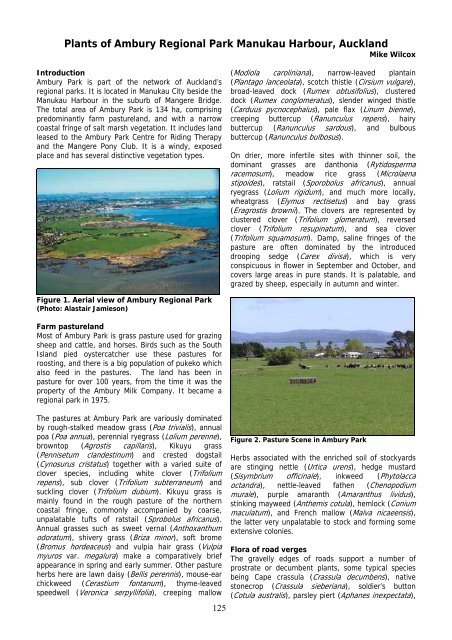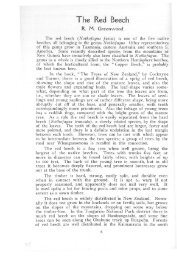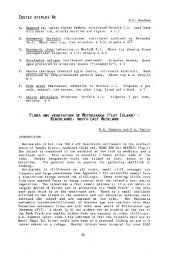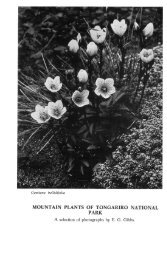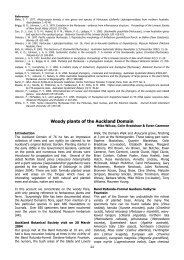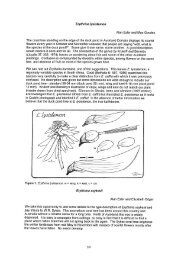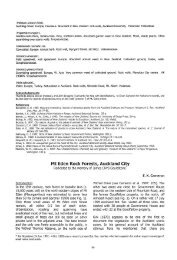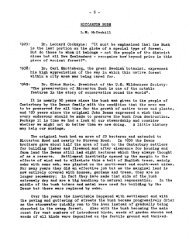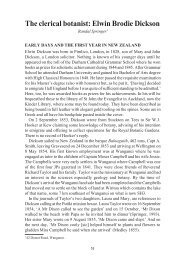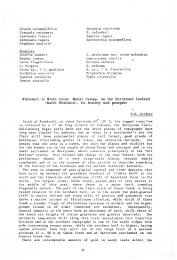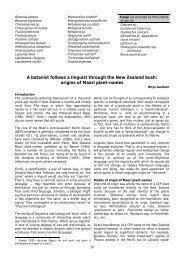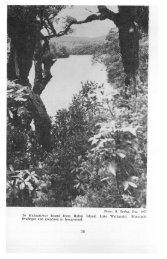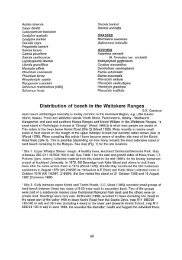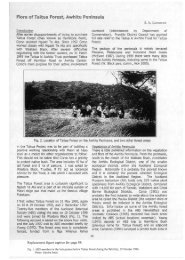Plants of Ambury Regional Park Manukau Harbour, Auckland
Plants of Ambury Regional Park Manukau Harbour, Auckland
Plants of Ambury Regional Park Manukau Harbour, Auckland
You also want an ePaper? Increase the reach of your titles
YUMPU automatically turns print PDFs into web optimized ePapers that Google loves.
<strong>Plants</strong> <strong>of</strong> <strong>Ambury</strong> <strong>Regional</strong> <strong>Park</strong> <strong>Manukau</strong> <strong>Harbour</strong>, <strong>Auckland</strong><br />
Mike Wilcox<br />
Introduction<br />
<strong>Ambury</strong> <strong>Park</strong> is part <strong>of</strong> the network <strong>of</strong> <strong>Auckland</strong>’s<br />
regional parks. It is located in <strong>Manukau</strong> City beside the<br />
<strong>Manukau</strong> <strong>Harbour</strong> in the suburb <strong>of</strong> Mangere Bridge.<br />
The total area <strong>of</strong> <strong>Ambury</strong> <strong>Park</strong> is 134 ha, comprising<br />
predominantly farm pastureland, and with a narrow<br />
coastal fringe <strong>of</strong> salt marsh vegetation. It includes land<br />
leased to the <strong>Ambury</strong> <strong>Park</strong> Centre for Riding Therapy<br />
and the Mangere Pony Club. It is a windy, exposed<br />
place and has several distinctive vegetation types.<br />
Figure 1. Aerial view <strong>of</strong> <strong>Ambury</strong> <strong>Regional</strong> <strong>Park</strong><br />
(Photo: Alastair Jamieson)<br />
Farm pastureland<br />
Most <strong>of</strong> <strong>Ambury</strong> <strong>Park</strong> is grass pasture used for grazing<br />
sheep and cattle, and horses. Birds such as the South<br />
Island pied oystercatcher use these pastures for<br />
roosting, and there is a big population <strong>of</strong> pukeko which<br />
also feed in the pastures. The land has been in<br />
pasture for over 100 years, from the time it was the<br />
property <strong>of</strong> the <strong>Ambury</strong> Milk Company. It became a<br />
regional park in 1975.<br />
The pastures at <strong>Ambury</strong> <strong>Park</strong> are variously dominated<br />
by rough-stalked meadow grass (Poa trivialis), annual<br />
poa (Poa annua), perennial ryegrass (Lolium perenne),<br />
browntop (Agrostis capillaris), Kikuyu grass<br />
(Pennisetum clandestinum) and crested dogstail<br />
(Cynosurus cristatus) together with a varied suite <strong>of</strong><br />
clover species, including white clover (Trifolium<br />
repens), sub clover (Trifolium subterraneum) and<br />
suckling clover (Trifolium dubium). Kikuyu grass is<br />
mainly found in the rough pasture <strong>of</strong> the northern<br />
coastal fringe, commonly accompanied by coarse,<br />
unpalatable tufts <strong>of</strong> ratstail (Sprobolus africanus).<br />
Annual grasses such as sweet vernal (Anthoxanthum<br />
odoratum), shivery grass (Briza minor), s<strong>of</strong>t brome<br />
(Bromus hordeaceus) and vulpia hair grass (Vulpia<br />
myuros var. megalura) make a comparatively brief<br />
appearance in spring and early summer. Other pasture<br />
herbs here are lawn daisy (Bellis perennis), mouse-ear<br />
chickweed (Cerastium fontanum), thyme-leaved<br />
speedwell (Veronica serpyllifolia), creeping mallow<br />
125<br />
(Modiola caroliniana), narrow-leaved plantain<br />
(Plantago lanceolata), scotch thistle (Cirsium vulgare),<br />
broad-leaved dock (Rumex obtusifolius), clustered<br />
dock (Rumex conglomeratus), slender winged thistle<br />
(Carduus pycnocephalus), pale flax (Linum bienne),<br />
creeping buttercup (Ranunculus repens), hairy<br />
buttercup (Ranunculus sardous), and bulbous<br />
buttercup (Ranunculus bulbosus).<br />
On drier, more infertile sites with thinner soil, the<br />
dominant grasses are danthonia (Rytidosperma<br />
racemosum), meadow rice grass (Microlaena<br />
stipoides), ratstail (Sporobolus africanus), annual<br />
ryegrass (Lolium rigidum), and much more locally,<br />
wheatgrass (Elymus rectisetus) and bay grass<br />
(Eragrostis brownii). The clovers are represented by<br />
clustered clover (Trifolium glomeratum), reversed<br />
clover (Trifolium resupinatum), and sea clover<br />
(Trifolium squamosum). Damp, saline fringes <strong>of</strong> the<br />
pasture are <strong>of</strong>ten dominated by the introduced<br />
drooping sedge (Carex divisa), which is very<br />
conspicuous in flower in September and October, and<br />
covers large areas in pure stands. It is palatable, and<br />
grazed by sheep, especially in autumn and winter.<br />
Figure 2. Pasture Scene in <strong>Ambury</strong> <strong>Park</strong><br />
Herbs associated with the enriched soil <strong>of</strong> stockyards<br />
are stinging nettle (Urtica urens), hedge mustard<br />
(Sisymbrium <strong>of</strong>ficinale), inkweed (Phytolacca<br />
octandra), nettle-leaved fathen (Chenopodium<br />
murale), purple amaranth (Amaranthus lividus),<br />
stinking mayweed (Anthemis cotula), hemlock (Conium<br />
maculatum), and French mallow (Malva nicaeensis),<br />
the latter very unpalatable to stock and forming some<br />
extensive colonies.<br />
Flora <strong>of</strong> road verges<br />
The gravelly edges <strong>of</strong> roads support a number <strong>of</strong><br />
prostrate or decumbent plants, some typical species<br />
being Cape crassula (Crassula decumbens), native<br />
stonecrop (Crassula sieberiana), soldier’s button<br />
(Cotula australis), parsley piert (Aphanes inexpectata),
Onehunga weed (Soliva sessilis), annual mouse-ear<br />
chickweed (Cerastium glomeratum), pearlwort (Sagina<br />
apetala), allseed (Polycarpon tetraphyllum), sand<br />
spurrey, (Spergularia rubra), catchfly (Silene vulgaris),<br />
field speedwell (Veronica arvensis), scrambling<br />
speedwell (Veronica persica), creeping mallow<br />
(Modiola caroliniana), field madder (Sherardia<br />
arvensis), scarlet pimpernel (Anagallis arvensis),<br />
annual poa (Poa annua), narrow-leaved plantain<br />
(Plantago lanceolata), white clover, spotted bur<br />
medick (Medicago arabica), bur medick (Medicago<br />
nigra), suckling clover (Trifolium dubium) [ <strong>of</strong>ten<br />
reddish in colour], hairy birdsfoot trefoil (Lotus<br />
suaveolens), native oxalis (Oxalis exilis), horned oxalis<br />
(Oxalis corniculata), purple cudweed (Gamochaeta<br />
coarctata), Japanese cudweed (Euchiton sphaericus),<br />
and cudweed (Gamochaeta purpurea). Cracks<br />
between cobblestones at the Visitor Centre have<br />
Hydrocotyle moschata, Poa annua and Sagina<br />
procumbens. There is a population <strong>of</strong> fluellen (Kickxia<br />
elatine) beside the road entrance from Kiwi Esplanade.<br />
The terrestrial blue-green alga (Cyanobacteria) Nostoc<br />
commune, comprising yellowish–brown gelatinous<br />
colonies, can be found amongst the vegetation on<br />
damp ground.<br />
Exotic trees<br />
The farmland in the park proper is bare <strong>of</strong> trees, but<br />
on the land leased to the <strong>Ambury</strong> <strong>Park</strong> Centre for<br />
Riding Therapy and the Mangere Pony club there are<br />
some tall gum trees (Eucalyptus botryoides, E.<br />
bicostata, and a lone E. globulus), two macrocarpa<br />
trees (Cupressus macrocarpa), a small belt <strong>of</strong><br />
lawsoniana (Chamaecyparis lawsoniana), some radiata<br />
pine (Pinus radiata), pin oak (Quercus palustris), claret<br />
ash (Fraxinus angustifolia subsp. oxycarpa ‘Raywood’,<br />
and a few hybrid poplars (Populus Xcanadensis). At<br />
the <strong>Park</strong> headquarters are some specimens <strong>of</strong> exotic<br />
trees, including avocado (Persea americana), Indian<br />
bead tree (Melia azedarach, flaky juniper (Juniperus<br />
squamata), Chinese juniper (Juniperus chinensis),<br />
brushbox (Lophostemon confertus), Norfolk Island<br />
hibiscus (Lagunaria patersonia), and white bottlebrush<br />
(Callistemon salignus).<br />
Figure 3. A road verge<br />
126<br />
Native copses<br />
A number <strong>of</strong> shelter belts and copses <strong>of</strong> native trees<br />
and shrubs were established in 1980 by the ARC<br />
landscape team, augmented by public participation on<br />
Arbor Day. Most <strong>of</strong> these were subsequently fenced <strong>of</strong>f<br />
from grazing, though some are used as a shelter for<br />
sheep during the spring lambing season. Pukekos use<br />
the copses in spring for nesting.<br />
Figure 4. A native copse<br />
The dominant species in the copses, which are now 8-<br />
10 m tall, are taupata (Coprosma repens), karo<br />
(Pittosporum crassifolium), houpara (Pseudopanax<br />
lessonii), broadleaf (Griselinia littoralis), pohutukawa<br />
(Metrosideros excelsa), ngaio (Myoporum laetum),<br />
cabbage tree (Cordyline australis), and manuka<br />
(Leptospermum scoparium). Australian ngaio<br />
(Myoporum insulare) has also been planted in the<br />
copses and has grown well. Taupata and karo are<br />
notable in being the only species to have regenerated<br />
prolifically from self-sown seedlings on the margins<br />
and in gaps. In one copse there has also been some<br />
localised seedling regeneration <strong>of</strong> wharangi, and<br />
mapou has occasionally set seedlings. Although not<br />
native to coastal <strong>Auckland</strong>, broadleaf has grown<br />
particularly well. Other species present are lacebark<br />
(Hoheria populnea), lemonwood (Pittosporum<br />
eugenioides), kohuhu (Pittosporum tenuifolium),<br />
akeake (Dodonaea viscosa), karaka (Corynocarpus<br />
laevigata), kanuka (Kunzea ericoides), kowhai<br />
(Sophora microphylla), tawapou (Pouteria costata),<br />
coastal twiggy coprosma (Coprosma crassifolia), puriri<br />
(Vitex lucens) and Chatham Island tree daisy (Olearia<br />
traversii).<br />
There has been no natural development <strong>of</strong> a native<br />
understorey or herb and fern ground cover, and the<br />
copses still have an artificial “planted” look. Some<br />
plants favouring the copses are veld grass (Ehrharta<br />
erecta), cocksfoot (Dactylis glomerata), ripgut brome<br />
(Bromus diandrus), praire grass (Bromus willdenowii),<br />
meadow rice grass (Microlaena stipoides), grey sedge<br />
(Carex divulsa), smilax (Asparagus asparagoides), cutleaved<br />
cranesbill (Geranium dissectum) and doves-foot<br />
cranesbill (Geranium molle), storksbill (Erodium
cicutarium), Mercury Bay weed (Dichondra repens),<br />
puha (Sonchus oleraceus), Indian strawberry<br />
(Duchesnea indica), spreading hedge parsley (Torilis<br />
arvensis), and extensively, Italian arum (Arum<br />
italicum). Open disturbed areas have an abundance <strong>of</strong><br />
ox-tongue (Helminthotheca echioides).<br />
On 5 May 2004 the Chinese Conservation Education<br />
Trust planted 1700 native trees, mostly in a newly<br />
fenced <strong>of</strong>f site in the southern wetland area. Species<br />
were kowhai, mapou, kanuka, karamu, koromiko,<br />
titoki, lacebark, akeake, kahikatea, karaka, whau, and<br />
also three species not otherwise recorded in copses at<br />
<strong>Ambury</strong> <strong>Park</strong> – pukatea (Laurelia novae-zelandiae),<br />
taraire (Beilschmiedia tarairi), and ribbonwood<br />
(Plagianthus regius) – but their survival seems<br />
doubtful in such a windy, exposed situation.<br />
The only native tree species which seems fully natural<br />
in <strong>Ambury</strong> <strong>Park</strong> is karo, represented by a few trees<br />
near the coast, including two on a rocky islet, amongst<br />
Phormium tenax. There are two large pohutukawa,<br />
and some old, gnarled taupata, but it is thought these<br />
were planted many years ago (the taupata are in<br />
rows!).<br />
Freshwater wetlands<br />
There are two ponds, which usually dry out completely<br />
in summer, and other small, damp, low-lying areas,<br />
the dominant tall plant in which is hollow rush (Juncus<br />
australis). Another tall native rush – the shiny green<br />
Juncus edgariae – is also present. Other plants <strong>of</strong><br />
these damp places are penny royal (Mentha pulegium)<br />
which is abundant and noticeable by its strong minty<br />
smell, milfoil (Myriophyllum propinquum), starwort<br />
(Callitriche stagnalis), purple loosestrife (Lythrum<br />
hyssopifolia), toad rush (Juncus bufonius), creeping<br />
buttercup (Ranuculus repens), celery-leaved buttercup<br />
(Ranunculus sceleratus), clustered dock (Rumex<br />
conglomeratus), and marsh bedstraw (Galium<br />
palustre). The ponds sometimes have marginal<br />
colonies <strong>of</strong> watercress (Nasturtium <strong>of</strong>ficinale), dense<br />
swards <strong>of</strong> water paspalum (Paspalum distichum), and<br />
fringes <strong>of</strong> semi-aquatic Bermuda grass (Cynodon<br />
dactylon) and creeping bent (Agrostis stolonifera).<br />
Water speedwell (Veronica anagallis-aquatica), is<br />
conspicuous in October with its attractive racemes <strong>of</strong><br />
mauve flowers. Duckweed (Lemna minor) may be<br />
found on the surface <strong>of</strong> shallow ponds and slowflowing<br />
ditches, and Isolepis sepulcralis at the edges <strong>of</strong><br />
ditches.<br />
Mangroves, salt meadows and basaltic lava<br />
flows<br />
Mangroves (Avicennia marina subsp. australasica)<br />
occur only sporadically in <strong>Ambury</strong> <strong>Park</strong> in sheltered,<br />
muddy bays in between the black basaltic lava rocks.<br />
They are much more abundant in other parts <strong>of</strong> the<br />
<strong>Manukau</strong> <strong>Harbour</strong> (Chapman & Ronaldson 1958).<br />
127<br />
Salt meadows are an attractive feature <strong>of</strong> the <strong>Ambury</strong><br />
<strong>Park</strong> foreshore. The plant covering the largest area in<br />
the salt marshes is New Zealand glasswort<br />
(Sarcocornia quinqueflora). This succulent occurs in<br />
distinctive clonal patches, commonly glaucous, bright<br />
green, or purplish. Also very common are sea primrose<br />
or maakoako (Samolus repens), with attractive white<br />
flowers in January, and sea plantain (Plantago<br />
coronopus) which forms extensive colonies <strong>of</strong> rosettes.<br />
Orache (Atriplex prostrata) is an introduced weed <strong>of</strong><br />
prostrate habit from Eurasia and N. Africa. It is<br />
common in New Zealand near the coast on shingle<br />
banks, fringing mud flats, and occurs all along the<br />
fringes <strong>of</strong> Kiwi Esplanade and commonly all around the<br />
<strong>Manukau</strong> <strong>Harbour</strong> shores. Less common are remuremu<br />
(Selliera radicans), slender clubrush (Isolepis cernua),<br />
sea spurrey (Spergularia media), sea blite (Suaeda<br />
novae-zelandiae), and bachelor’s button (Cotula<br />
coronopifolia). The dominant monocotyledons are<br />
shore tussock or needle tussock (Austrostipa stipoides)<br />
and salt-marsh rush (Juncus kraussii var. australiensis)<br />
and salt marsh carex. Oioi (Apodasmia similis) occurs<br />
only sporadically.<br />
Figure 5. Stand <strong>of</strong> hollow rush (Juncus australis)<br />
Salt grass (Puccinellia stricta) can be found growing<br />
amongst glasswort during the spring and summer. It<br />
seems to be perennial and is <strong>of</strong>ten quite conspicuous,<br />
growing on hummocks <strong>of</strong> shell with a peaty soil, with<br />
glasswort and sea plantain. <strong>Ambury</strong> <strong>Park</strong> is the main<br />
site in <strong>Auckland</strong> for this grass. It also occurs in the<br />
Onehunga-Te Papapa coastal fringe, but not<br />
apparently at all in the Waitemata <strong>Harbour</strong>.<br />
The introduced annual beard grass (Polypogon<br />
monspeliensis), barley grass (Critesion murinum) and<br />
the barb grasses (Parapholis recurva and P. strigosa)<br />
are conspicuous at the ecotone between pasture and<br />
salt marsh. On one site adjoining a freshwater outlet<br />
<strong>of</strong>f Kiwi Esplanade are colonies <strong>of</strong> arrow-grass<br />
(Triglochin striata), but it has not been seen in <strong>Ambury</strong><br />
<strong>Park</strong> itself.
Figure 6. Mangroves and salt meadow<br />
Figure 7: Salt grass (Puccinellia stricta) growing<br />
amongst glasswort (Sarcocornia quinqueflora)<br />
A man-made rock wall amongst mangroves supports<br />
an impressive population <strong>of</strong> the native succulent<br />
Crassula sieberiana, together with a robust and<br />
luxuriant form <strong>of</strong> the foliose lichen Ramalina celastri.<br />
Figure 8. The native stonecrop (Crassula sieberiana)<br />
is commonly found on sea walls and gravelly road<br />
verges<br />
A shrub which is well established at <strong>Ambury</strong> <strong>Park</strong> on<br />
the rocky sea shore is African boxthorn (Lycium<br />
ferocissimum). It is a spiny evergreen shrub from<br />
South Africa, and thrives on coastal sites. Other<br />
128<br />
introduced shrubs here are gorse (Ulex europaeus),<br />
and occasionally, thornapple or apple <strong>of</strong> Sodom<br />
(Solanum linnaeanum). Growing amongst rocks in<br />
these scrubby areas is pohuehue (Muehlenbeckia<br />
axillaris) and smilax. A small rocky islet has a patch <strong>of</strong><br />
New Zealand spinach (Tetragonia tetragonioides), and<br />
there are just a few plants <strong>of</strong> native celery (Apium<br />
prostratum) growing on islets amongst lava rocks.<br />
Shore ribbonwood (Plagianthus divaricatus) is very<br />
rare in <strong>Ambury</strong> <strong>Park</strong>.<br />
Figure 9. Sea celery (Apium prostratum)<br />
Figure 10. New Zealand spinach (Tetragonia<br />
tetragonioides)<br />
Algae<br />
A number <strong>of</strong> algae can be found on the black lava<br />
rocks in the mid and upper tidal zone. A short<br />
brownish-coloured alga growing colonially in short,<br />
s<strong>of</strong>t clumps is Caloglossa leprieurii. This seaweed can<br />
also be found on the pneumatophores <strong>of</strong> mangroves.<br />
Green algae <strong>of</strong> this zone are the filamentous<br />
Rhizoclonium implexum, growing in greenish wefts<br />
that may be bleached by the sun, a type <strong>of</strong> sea<br />
lettuce, Monostroma latissimum, and Enteromorpha<br />
compressa. The red seaweed Gracilaria chilensis is<br />
abundant as a free-living seaweed on muddy<br />
backwaters, and washes up on mass.
Lichens and bryophytes<br />
Lecanora subcoarctata is a crustose lichen found on<br />
coastal rocks near high tide limit. It forms grey-white<br />
patches that are areolate-cracked. Below this and<br />
<strong>of</strong>ten under water at high tide, the dominant lichen is<br />
the very common yellow species, Xanthoria ligulata –<br />
one <strong>of</strong> the most prominent features <strong>of</strong> the rocky shore,<br />
and inland from it, grey lichens. Grey lichens on the<br />
reefs and rock walls which are a feature <strong>of</strong> <strong>Ambury</strong><br />
<strong>Park</strong> and the Mangere Bridge area are Canoparmelia<br />
cineracens, Rimelia reticulata, Dirinaria applanata,<br />
Heterodermia speciosa, Flavoparmelia soredians,<br />
Physcia poncinsii and the powdery Lepraria incana.<br />
Yellow lichens found on the bark <strong>of</strong> trees and on twigs<br />
are Xanthoria parietina and Teloschistes<br />
chrysophthalmus, and perhaps the commonest grey<br />
lichen on the bark <strong>of</strong> trees such as pohutukawa is<br />
Heterodermia speciosa.<br />
Common mosses on and around protruding boulders in<br />
the pastures are Hypnum cupressiforme, Triquetrella<br />
papillata, Campylopus clavatus, Tortula princeps, and<br />
Bryum campylothecium, and white feather moss<br />
(Brachythecium albicans), Thuidium furfurosum and<br />
Kindbergia praelonga can be found in damp pasture.<br />
Figure 11. The yellow lichen Xanthoria ligulata<br />
Accompanying the mosses are several small annual<br />
flowering plants, also found on dry road edges, namely<br />
vulpia hair grass (Vulpia bromoides), annual poa (Poa<br />
annua), Cape crassula (Crassula decumbens), native<br />
stonecrop (Crassula sieberiana), creeping oxalis (Oxalis<br />
exilis), pearlwort (Sagina apetala), allseed (Polycarpon<br />
tetraphyllum), and also slender bedstraw (Galium<br />
divaricatum). Nearby Mangere Mountain has a similar<br />
129<br />
saxicolous moss flora (Beever 1983). Tortula muralis,<br />
Bryum argenteum and Grimmia pulvinata can be found<br />
on exposed stone walls.<br />
Figure 12. The moss Grimmia pulvinata on a stone<br />
wall<br />
Mountain moss (Racomitrium lanuginosum) used to be<br />
present on the lava flows but it seems to have<br />
disappeared in recent years. The moss Ceratodon<br />
purpureus occurs on compact, bare soil on road edges.<br />
Shaded stone walls support green mats <strong>of</strong> the moss<br />
Racopilum convolutaceum and felts <strong>of</strong> the liverworts<br />
Frullania solanderiana and Chiloscyphus semiteres.<br />
Summary and conclusions<br />
This study <strong>of</strong> the plants found in <strong>Ambury</strong> <strong>Park</strong> has<br />
brought to light a surprising biodiversity, considering<br />
there is no natural native bush, the environment is<br />
highly modified, and the park is heavily stocked with<br />
sheep. The wild native flora is very restricted, yet<br />
there are healthy populations <strong>of</strong> some lesser known<br />
species such as Crassula sieberiana and Puccinellia<br />
stricta, and wild plants <strong>of</strong> two native vegetables, New<br />
Zealand spinach and native celery. The 24-year-old<br />
planted native copses usefully demonstrate the<br />
capabilities <strong>of</strong> various species to thrive in this windy,<br />
coastal environment, with Pittosporum crassifolium,<br />
Myoporum laetum, M. insulare, Coprosma repens and<br />
Coprosma crassifolia being particularly good<br />
performers. <strong>Ambury</strong> <strong>Park</strong> has a good representation <strong>of</strong><br />
<strong>Auckland</strong>’s naturalised plants (Esler 1988, 2004), and a<br />
few unusual or rare ones such as the Australian grass<br />
Elymus rectisetus and the European herb Kickxia<br />
elatine.<br />
References<br />
Beever, J. E. 1983. The saxicolous mosses <strong>of</strong> Mangere Mountain. <strong>Auckland</strong> Botanical Society Newsletter 38(1):15-16.<br />
Chapman, V. J.; Ronaldson, J. W. 1958: The mangrove and salt-marsh flats <strong>of</strong> the <strong>Auckland</strong> Isthmus. Bulletin No. 125, DSIR.<br />
Esler, A. E. 1988. Naturalisation <strong>of</strong> plants in urban <strong>Auckland</strong>. DSIR Publishing, Wellington.<br />
Esler, A. 2004. Wild plants in <strong>Auckland</strong>. <strong>Auckland</strong> University Press, <strong>Auckland</strong>.
Species List<br />
(# = wild native; * = wild exotic; § = cultivated native; *§ = cultivated exotic)<br />
Algae<br />
Caloglossa leprieurii (Mont.) J.Agardh coastal rocks and mangroves<br />
Enteromorpha compressa (L.) Nees coastal rocks<br />
Gracilaria chilensis Bird, McLachlan & Oliveira mud flats<br />
Monostroma latissimum Wittr. coastal rocks<br />
Nostoc commune Vaucher damp road margins<br />
Rhizoclonium implexum (Dillwyn) Kuetz. coastal rocks<br />
Lichens<br />
Canoparmelia cinerascens (Lynge) Elix & Hale coastal rocks<br />
Chrysothrix candelaris (L.) Laundon on bark, a green “paint”<br />
Cladonia ramulosa (With.) J.R.Laundon inside old macrocarpa stumps<br />
Dirinaria applanata (Feé) Awasthi bark <strong>of</strong> trees<br />
Flavoparmelia soredians (Nyl.) Hale coastal rocks<br />
Heterodermia speciosa (Wulfen) Trevis on scoria walls<br />
Lecanora subcoarctata (C. Knight) Hertel rocks and walls<br />
Lepraria incarna (L.) Ach. powdery grey-green crust on walls<br />
Parmotrema chinense (Osbeck) Hale & Ahti rock walls<br />
Physcia poncinsii Hue rock walls<br />
Ramalina celastri (Spreng.) Krog & Swinscow on tree branches<br />
Rimelia reticulata (Taylor) Hale & A.Fletcher stone walls<br />
Teloschistes chrysophthalmus (L.) Th.Fr. on kanuka twigs<br />
Usnea rubicunda Stirton stone wall<br />
Xanthoparmelia scabrosa (Taylor) Hale on tar seal<br />
Xanthoria ligulata (Körber) P.James yellow “paint” on coastal rocks<br />
Xanthoria parietina (L.) Th.Fr. on tree trunks, palings and bark<br />
Liverworts<br />
Chiloscyphus semiteres (Lehm.) Lehm. & Lindenb. on damp rock wall, <strong>Park</strong> HQ<br />
Frullania solanderiana Col. rock wall, Centre for Riding<br />
Therapy<br />
Mosses<br />
Brachythecium albicans (Hedw.) Schimp. pasture, mangere pony club area<br />
Bryum argenteum Hedw. top <strong>of</strong> stone wall, <strong>Park</strong> HQ.<br />
Bryum campylothecium Tayl. on stone walls and rock outcrops<br />
Bryum capillare Hedw.<br />
Campylopus clavatus (R.Br.) Wils. rock outcrops<br />
Campylopus intr<strong>of</strong>lexus (Hedw.) Brid. top <strong>of</strong> stone wall, <strong>Park</strong> HQ; in old<br />
hollow macrocarpa stumps.<br />
Ceratodon purpureus (Hedw.) Brid. compact bare soil on road edges<br />
Fissidens taxifolius Hedw. patches on shaded ground, <strong>Park</strong><br />
HQ<br />
Grimmia pulvinata (Hedw.) Sm. ex Sm. & Sowerby stone walls<br />
Hypnum cupressiforme Hedw. var. cupressiforme base <strong>of</strong> rocky outcrops<br />
Kindbergia praelonga (Hedw.) Ochyra grassy areas near <strong>Park</strong> HQ<br />
Racopilum convolutaceum (C. Muell.) Reichdt. shaded rock outcrops and walls<br />
Thuidium furfurosum (Hook.f. & Wils.) Reichdt. grassy area<br />
Tortula muralis Hedw stone walls<br />
Tortula papillosa Wils.<br />
Tortula princeps De Not. rocky outcrops<br />
Triquetrella papillata (Hook.f. & Wils.) Broth. on rock outcrops<br />
Ferns<br />
§ Dicksonia squarrosa (Forst.f.) Swartz common punga<br />
# Hypolepis distans Hook.<br />
* Nephrolepis cordifolia (L.) Presl ladder fern, fishbone fern<br />
# Pteris tremula R. Br. shaking brake, turawera<br />
# Pyrrosia eleagnifolia (Bory) Hovenkamp leather-leaf fern<br />
130
Conifers<br />
§ Agathis australis (D.Don) Lindley kauri<br />
*§ Chamaecyparis lawsoniana (A.Murr.) Parl. lawsoniana, Port Orford cedar,<br />
Lawson's cypress<br />
*§ Cryptomeria japonica (L.f.) D.Don Japanese cedar, sugi<br />
*§ Cupressus macrocarpa Hartw. ex Gord. macrocarpa, Monterey cypress<br />
§ Dacrycarpus dacrydioides (A.Rich.) de Laub. kahikatea, white pine<br />
*§ Juniperus chinensis L. Chinese juniper (variegated<br />
cultivar)<br />
*§ Juniperus squamata Buch.-Ham. ex D.Don flaky juniper<br />
*§ Pinus radiata D.Don Monterey pine, radiata pine<br />
§ Podocarpus totara G. Benn. ex D.Don var. totara totara<br />
Dicot trees, shrubs and climbers<br />
*§ Acmena smithii (Poiret) Merr. & Perry lilly pilly<br />
§ Alectryon excelsus Gaertner titoki<br />
*Anredera cordifolia (Ten.) Steenis Madeira vine or mignonette vine<br />
*Araujia sericifera Brot. moth plant<br />
# Avicennia marina subsp. australasica (Walp.) J.Everett mangrove, manawa<br />
*§ Berberis glaucocarpa Stapf common barberry<br />
§ Brachyglottis greyi (Hook.f.) Nordenstam Grey's shrub daisy<br />
*§ Buddleja salviifolia (L.) Lam. sagewood, wild sage<br />
*§ Callistemon salignus (Smith) Sweet white or willow bottlebrush<br />
*§ Camellia reticulata Lindley Camellia<br />
§ Carpodetus serratus J.R. & G.Forst. putaputaweta, marbleleaf<br />
*§ Casuarina cunninghamiana Miq. common river sheoak<br />
* Cinnamomum camphora (L.) J.S.Presl camphor tree<br />
*§ Citrus Xparadisi Macfad. grapefruit<br />
§ Coprosma crassifolia Col. coastal twiggy coprosma<br />
§ Coprosma Xcunninghamii Hook.f. (C. robusta x C. propinqua) hybrid coprosma<br />
§ Coprosma Xkirkii Cheesem. (C. repens x C. acerosa) hybrid coprosma<br />
§ Coprosma repens A.Rich. taupata<br />
§ Coprosma robusta Raoul karamu<br />
§ Corokia buddleioides A.Cunn. korokia<br />
§ Corokia Xvirgata Turrill (C. buddleioides x C. cotoneaster) hybrid korokia<br />
§ Corynocarpus laevigatus J. R.& G.Forst. karaka<br />
§ Dodonaea viscosa (L.) Jacq. subsp. viscosa akeake<br />
§ Entelea arborescens R.Br. whau<br />
*§ Eucalyptus bicostata Maiden, Blakely & J.Simmonds Victorian blue gum<br />
*§ Eucalyptus botryoides Sm. southern mahogany, bangalay<br />
*§ Eucalyptus globulus Labill. blue gum<br />
*§ Euryops abrotanifolius (L.) DC. Paris daisy<br />
*§ Ficus benjamina L. weeping fig<br />
§ Fraxinus angustifolia subsp. oxycarpa (Bieb. ex Willd.) Franco & Caucasian ash, claret ash<br />
Rocha Afonso cv. 'Raywood'<br />
§ Griselinia littoralis Raoul broadleaf, papaumu<br />
§ Hebe parviflora (Vahl) Ckn. & Allan hebe<br />
§ Hebe stricta (Benth.) L.B.Moore common koromiko<br />
* Hedera helix L. ivy<br />
*§ Hibiscus rosa-sinensis L. hibiscus<br />
§ Hoheria populnea A. Cunn. lacebark, houhere<br />
* Impatiens sodenii Engl. shrub balsam<br />
* Jasminum polyanthum Franchet jasmine<br />
*§ Juglans regia L. European walnut<br />
§ Kunzea ericoides (A.Rich.) J.Thompson Kanuka<br />
*§ Lagunaria patersonia (Andrews) G.Don subsp. patersonia Norfolk Island hibiscus<br />
§ Laurelia novae-zelandiae A.Cunn. pukatea<br />
*§ Lavandula dentata L. toothed lavender<br />
§ Leptospermum scoparium J.R. & G.Forst. tea tree, manuka<br />
* Ligustrum sinense Lour. Chinese privet<br />
* Lonicera japonica Thunb. Japanese honeysuckle<br />
131
*§ Lophostemon confertus (R.Br.) P.G. Wilson & J.T.Waterhouse brushbox<br />
* Lycium ferocissimum Miers African boxthorn<br />
§ Macropiper excelsum (Forst.f.) Miq. subsp. excelsum kawakawa<br />
*§ Melia azedarach L. Persian lilac<br />
§ Melicope ternata J.R. & G.Forst. wharangi<br />
§ Melicytus ramiflorus J.R. & G.Forst. subsp. ramiflorus mahoe, whiteywood<br />
§ Metrosideros excelsa Sol. Ex Gaertner pohutukawa<br />
# Muehlenbeckia complexa (A.Cunn.) Meissn. wire vine, beach pohuehue<br />
*§ Myoporum insulare R.Br. Australian ngaio<br />
§ Myoporum laetum Forst.f. ngaio<br />
§ Myrsine australis (A. Rich.) Allan mapou<br />
§ Olearia paniculata (J.R. & G.Forst.) Druce akiraho<br />
§ Olearia traversii (F.Muell.) Hook.f. akeake, Chatham Is. tree daisy<br />
*§ Paraserianthes lophantha (Willd.) Nielsen subsp. lophantha brush wattle, crested wattle,<br />
stinkbean<br />
*§ Paulownia tomentosa (Thunb.) Steud hairy paulownia, princess tree<br />
*§ Persea americana Mill. avocado<br />
§ Pittosporum colensoi Hook.f. montane kohuhu<br />
§ Pittosporum crassifolium Banks & Sol. ex A.Cunn. karo (wild and cult.)<br />
§ Pittosporum eugenioides A.Cunn. lemonwood, tarata<br />
§ Pittosporum tenuifolium Sol. ex Gaertner kohuhu<br />
§ Pittosporum umbellatum Banks & Sol. ex Gaertner haekaro<br />
# Plagianthus divaricatus J.R & G.Forst. shore ribbonwood<br />
*§ Populus Xcanadensis Moench hybrid poplar (cultivar <strong>of</strong> Populus<br />
nigra x Populus deltoides)<br />
§Pouteria costata (Endl.) Baehni tawapou<br />
* Prunus persica (L.) Batsch peach<br />
§ Pseudopanax crassifolius (Sol. ex A.Cunn.) C. Koch lancewood<br />
§ Pseudopanax lessonii (DC.) C. Koch houpara, coastal five-finger<br />
§ Quercus palustris Muench. pin oak<br />
* Rhamnus alaternus L. evergreen buckthorn<br />
* Rubus fruticosus L. blackberry<br />
*§ Salix cinerea L. grey willow, sallow<br />
*§ Salvia sage (red-flowered aromatic shrub)<br />
*Solanum linnaeanum Hepper & P.M.Jaeger apple <strong>of</strong> Sodom, devil apple.<br />
*Solanum mauritianum Scop. woolly nightshade, tobacco weed.<br />
§Sophora microphylla Ait. kowhai<br />
*§ Spiraea cantoniensis Lour. spiraea<br />
* Ulex europaeus L. gorse<br />
§ Vitex lucens Kirk puriri<br />
*§ Wisteria sinensis (Sims) Sweet Chinese wisteria<br />
Dicot herbs<br />
* Acanthus mollis L. bear's britches<br />
* Amaranthus lividus L. purple amaranth<br />
* Anagallis arvensis L. subsp. arvensis var. arvensis scarlet pimpernel<br />
* Anagallis arvensis subsp. parviflora (H<strong>of</strong>fsgg. & Link) Arcang. blue pimpernel<br />
* Anthemis cotula L. stinking mayweed<br />
* Aphanes inexpectata Lippert parsley piert<br />
* Apium nodiflorum (L.) Lagasca water celery<br />
# Apium prostratum Vent. native celery<br />
* Arctium minus (Hill.) Bernh. common burdock<br />
* Arctotheca calendula (L.) Levyns Cape weed<br />
* Atriplex prostrata DC. orache<br />
* Bellis perennis L. lawn daisy<br />
*§ Calendula <strong>of</strong>ficinalis L. marigold<br />
* Callitriche stagnalis Scop. starwort<br />
* Calystegia sepium (L.) R.Br. pink bindweed<br />
# Calystegia soldanella (L.) R.Br. shore bindweed<br />
* Capsella bursa-pastoris (L.) Medikus shepherd's purse<br />
* Cardamine hirsuta L. bitter cress<br />
132
* Carduus pycnocephalus L. slender winged thistle<br />
* Centaurium erythraea Rafn. centaury<br />
* Cerastium fontanum Baumg. mouse-ear chickweed<br />
* Cerastium glomeratum Thuill. annual mouse-ear chickweed<br />
* Chenopodium murale L. nettle-leaved fat-hen<br />
* Chenopodium pumilio R.Br. clammy goosefoot.<br />
* Cirsium arvense (L.) Scop. Californian thistle<br />
* Cirsium vulgare (Savi) Ten. Scotch thistle<br />
* Conium maculatum L. hemlock<br />
* Conyza albida Sprengel broad-leaved fleabane<br />
* Coronopus didymus (L.) Smith twin cress<br />
# Cotula australis (Sprengel) Hook.f. soldier’s button<br />
* Cotula coronopifolia L. bachelor's button<br />
* Crassula decumbens Thunb. Cape crassula<br />
# Crassula sieberiana (Schultes & Schultes f.) G.C.Druce native stonecrop<br />
* Crepis capillaris (L.) Wallr. hawksbeard<br />
* Datura stramonium L. thornapple, jimpson weed<br />
* Daucus carota L. wild carrot, Queen Anne’s lace<br />
* Delairea odorata Lem. (syn. Senecio mikanioides Otto ex Walp.) Cape ivy, German ivy<br />
# Dichondra repens J.R.Forst. & G.Forst. native Mercury Bay weed<br />
* Duchesnea indica (Andrews) Focke Indian strawberry<br />
* Erigeron karvinskianus DC. Mexican daisy<br />
* Erodium cicutarium (L.) L’Hér. storksbill<br />
* Euchiton sphaericus (Willd.) Anderb. (syn. Gnaphalium sphaericum Japanese cudweed<br />
Willd.)<br />
*§ Euphorbia lathyris L. caper spurge<br />
* Euphorbia peplus L. milkweed<br />
*Foeniculum vulgare var. azoricum (Miller) Thell. fennel<br />
* Fumaria capreolata L. rampant fumitory<br />
* Fumaria muralis Koch scrambling fumitory<br />
* Galium aparine L. cleavers<br />
* Galium divaricatum Lam. slender bedstraw<br />
*Galium palustre L. marsh bedstraw<br />
* Gamochaeta coarctata (Willd.) Kerguelen (syn.Gnaphalium<br />
purple cudweed<br />
coarctatum Willd.)<br />
* Gamochaeta purpurea (L.) Cabrera cudweed<br />
*Geranium dissectum L. cut-leaved cranesbill<br />
* Geranium purpureum Villars small herb robert<br />
* Geranium molle L. dove’s-foot cranesbill<br />
# Geranium solanderi Carolin coastal cranesbill<br />
# Geranium aff. solanderi “coarse hairs” coastal cranesbill<br />
# Haloragis erecta (Banks ex Murray) Oken subsp. erecta shrubby haloragis, toatoa<br />
* Helianthus tuberosus L. Jerusalem artichoke<br />
* Helminthotheca echioides (L.) Holub (syn. Picris echioides L.) ox-tongue<br />
# Hydrocotyle moschata Forst.f. hydrocotyle<br />
* Hypochaeris radicata L. catsear<br />
* Kickxia elatine (L.) Dumort. fluellen<br />
* Lamium pupureum L. red dead nettle<br />
* Lapsana communis L. nipplewort<br />
* Lavatera cretica L. cretan mallow<br />
*Leontodon taraxicoides (Villars) Mérat hawkbit<br />
*Linum bienne Miller pale flax<br />
* Lotus pedunculatus Cav. (syn. Lotus uliginosus Schk.) lotus<br />
*Lotus suaveolens Pers. hairy birdsfoot trefoil<br />
*Lythrum hyssopifolia L. hyssop loosestrife<br />
* Malva nicaeensis All. French mallow<br />
*Malva parviflora L. mallow<br />
* Medicago arabica (L.) Hudson spotted bur medick<br />
* Medicago lupulina L. black medick<br />
*Medicago nigra (L.) Krocker bur medick<br />
*Melilotus indicus (L.) All. King Island melilot<br />
133
*Mentha pulegium L. penny royal<br />
* Mentha spicata L. spearmint<br />
* Mentha suaveolens Ehrh. apple mint<br />
*Modiola caroliniana (L.) G.Don creeping mallow.<br />
* Myosotis arvensis (L.) Hill field forget-me-not<br />
# Myriophyllum propinquum Cunn. native milfoil<br />
* Nasturtium <strong>of</strong>ficinale R.Br. (syn. Rorippa nasturtium-aquaticum (L.) watercress<br />
Hayek.)<br />
* Orobanche minor Smith broomrape<br />
* Osteospermum fruticosum (L.) Norlindh dimorphotheca, sailor-boy daisy<br />
* Oxalis corniculata L. horned oxalis, wood sorrel<br />
# Oxalis exilis Cunn. creeping oxalis<br />
* Oxalis incarnata L. lilac oxalis<br />
* Oxalis pes-caprae L. Bermuda buttercup<br />
* Pericallis Xhybrida R.Nordenstam cneraria<br />
* Plantago coronopus L. buck's horn plantain<br />
* Plantago lanceolata L. ribwort, narrow-leaved plantain<br />
* Plantago major L. broad-leaved plantain<br />
* Phytolacca octandra L. inkweed<br />
* Polycarpon tetraphyllum (L.) L. allseed<br />
* Polygonum arenastrum Boreau small-leaved wireweed<br />
* Polygonum aviculare L. wire-weed<br />
# Polygonum salicifolium Willd. swamp willow weed<br />
* Prunella vulgaris L. selfheal<br />
* Ranunculus bulbosus L. bulbous buttercup<br />
* Ranunculus muricatus L. spiny buttercup<br />
* Ranunculus parviflorus L. small-flowered buttercup<br />
* Ranunculus repens L. creeping buttercup<br />
* Ranunculus sardous Crantz hairy buttercup<br />
* Ranunculus sceleratus L. celery-leaved buttercup<br />
* Raphanus raphanistrum L. subsp. raphanistrum wild radish<br />
* Rumex conglomeratus Murray clustered dock<br />
* Rumex crispus L. curled dock<br />
* Rumex obtusifolius L. broad-leaved dock<br />
* Rumex pulcher L. fiddle dock<br />
* Rumex sagittatus Thunb. climbing dock<br />
* Sagina apetala Ard. pearlwort<br />
* Sagina procumbens L. procumbent pearlwort<br />
# Samolus repens (Forst. & Forst.f.) Pers. sea primrose, maakoako<br />
# Sarcocornia quinqueflora (Bunge ex Ung.-Sternb.) A.J.Scott (syn. New zealand glasswort<br />
Salicornia australis Sol. ex Benth.)<br />
# Selliera radicans Cav. remuremu<br />
* Senecio esleri Webb Esler’s fireweed, hairy legs<br />
groundsel<br />
* Senecio jacobaea L. ragwort<br />
* Senecio skirrodon DC. gravel groundsel<br />
* Senecio vulgaris L. groundsel<br />
* Sherardia arvensis L. field madder<br />
* Silene gallica L. catchfly<br />
* Sisymbrium <strong>of</strong>ficinale L. hedge mustard<br />
# Solanum americanum Miller small-flowered nightshade<br />
* Solanum chenopodioides Lam. velvety nightshade<br />
* Solanum nigrum L. black nightshade<br />
* Solanum tuberosum L. potato<br />
* Soliva sessilis Ruíz & Pavón Onehunga weed<br />
* Sonchus oleraceus L. sow thistle, milk thistle, puha<br />
* Spergularia media L. sea spurrey<br />
* Spergularia rubra (L.) J.Presl & C.Presl sand spurrey<br />
* Stachys arvensis (L.) L. stagger weed, field woundwort<br />
* Stellaria media (L.) Cirillo common stitchwort, chickweed<br />
# Suaeda novaezelandiae Allan native seablite<br />
134
* Symphytum Xuplandicum Nyman Russian comfrey<br />
* Taraxacum <strong>of</strong>ficinale G. Weber dandelion<br />
# Tetragonia tetragonioides (Pall.) O. Kuntze<br />
kokihi, New Zealand spinach<br />
* Torilis arvensis (Hudson) Link spreading hedge-parsley<br />
* Trifolium dubium Sibth. suckling clover<br />
* Trifolium glomeratum L. clustered clover<br />
* Trifolium micranthum Viv. lesser suckling clover<br />
* Trifolium pratense L. red clover<br />
* Trifolium repens L. white clover<br />
* Trifolium resupinatum L. persian clover, reversed clover<br />
* Trifolium squamosum L. sea clover<br />
* Trifolium subterraneum L. subterranean clover, sub clover<br />
* Tropaeolum majus L. garden nasturtium, indian cress<br />
* Urtica urens L. nettle<br />
* Verbena bonariensis L. purple-top<br />
* Veronica anagallis-aquatica L. water speedwell<br />
* Veronica arvensis L. field speedwell, wall speedwell<br />
* Veronica persica Poiret scrambling speedwell<br />
* Veronica serpyllifolia L. thyme-leaved speedwell<br />
* Vicia sativa L. common vetch<br />
* Vinca major L. periwinkle<br />
* Viola odorata L. violet<br />
* Xanthium spinosum L. clotbur, bathhurst bur<br />
Monocots<br />
*§ Agapanthus praecox subsp. orientalis (H<strong>of</strong>fmanns.) H.R.Wehrh<br />
(syn. A. orientalis F.M.Leight.).<br />
agapanthus<br />
* Agrostis capillaris L. (syn. Agrostis tenuis Sibth.) browntop<br />
* Agrostis stolonifera L. creeping bent<br />
* Aira caryophyllea L. subsp. caryophyllea silvery hair grass<br />
* Allium triquetrum L. three-cornered garlic, onion weed<br />
*§ Aloe ciliaris Haw. climbing aloe<br />
* Anthoxanthum odoratum Lagasca sweet vernal<br />
# Apodasmia similis (Edgar) B. G. Briggs & L. A. S. Johnson (syn.<br />
Leptocarpus similis Edgar)<br />
oioi, jointed wire rush<br />
*Arum italicum Miller Italian arum<br />
* Asparagus asparagoides L. (syn. Myrsiphyllum scandens (Thunb.)<br />
Oberm.)<br />
florist's smilax<br />
# Austrostipa stipoides (Hook.f.) Jacobs & Everett (syn. Stipa stipoides shore tussock, needle tussock,<br />
(Hook.f.) Veldkamp, syn. Stipa teretifolia Steud.)<br />
coastal immorality grass<br />
* Briza minor L. shivery grass<br />
* Bromus diandrus Roth ripgut brome, great brome<br />
* Bromus hordeaceus L. (syn. Bromus mollis L.) s<strong>of</strong>t brome<br />
* Bromus lithobius Trin. Chilean brome<br />
* Bromus willdenowii Kunth praire grass<br />
* Canna indica L.<br />
§ Carex comans Berggr.<br />
Indian shot<br />
* Carex divisa Huds. drooping sedge<br />
* Carex divulsa Stokes grey sedge<br />
# Carex flagellifera Col.<br />
§ Carex testacea Sol. ex Boott<br />
trip-me-up<br />
* Catapodium rigidum (L.) C.E.Hubb. (syn. Desmazeria rigida (L.)<br />
Tutin).<br />
fern grass, hard grass<br />
§ Cordyline australis (Forst.f.) Endl. cabbage tree, ti rakau<br />
* Cortaderia selloana (Schult.) Asch. & Graeb. pampas grass<br />
§ Cortaderia splendens Connor coastal toetoe<br />
* Critesion murinum (L.) Á. Löve subsp. murinum (syn. Hordeum wild barley, wall barley, barley<br />
murinum L. subsp. murinum).<br />
grass<br />
* Crocosmia Xcrocosmiiflora (Nicholson) N.E.Brown Montbretia<br />
* Cyperus congestus Vahl brown umbrella sedge<br />
# Cyperus ustulatus A. Rich. giant umbrella sedge, toetoe<br />
135
* Cynodon dactylon (L.) Pers.<br />
upoko-tangatu<br />
Bermuda grass, couch grass<br />
* Cynosurus cristatus L. crested dog's tail<br />
* Dactylis glomerata L. Cocksfoot<br />
* Digitaria sanguinalis (L.) Scop. summer grass, crab grass<br />
* Echinochloa crus-galli (L.) Beauv. barnyard grass<br />
* Ehrharta erecta Lam. veld grass<br />
* Eleusine indica (L.) Gaertn. crows foot grass, goose grass<br />
* Elymus rectisetus (Nees)Á.Löve & Connor wheatgrass<br />
* Elytrigia pycnantha (Godr.)Á.Löve sea couch<br />
* Eragrostis brownii (Kunth) Wight bay grass<br />
# Ficinia nodosa (Rottb.) Goetgh., Muasya & D.A.Simpson (formerly<br />
Isolepis nodosa (Rottb.) R.Br., Scirpus nodosus and Scirpoides<br />
nodosa (Rottb.) Soják.)<br />
knobby clubrush<br />
* Glyceria declinata Bréb. glaucous sweet grass<br />
* Holcus lanatus L. Yorkshire fog<br />
# Isolepis cernua (Vahl) Roem. & Schult. slender club-rush<br />
# Isolepis sepulcralis Steud. weeping club-rush<br />
* Juncus articulatus L. jointed rush<br />
# Juncus australis Hook.f. wiwi, hollow rush<br />
* Juncus bufonius L. toad rush<br />
# Juncus edgariae L.A.S. Johnson & K.L.Wilson wiwi, rush<br />
# Juncus kraussii Hochstr. Var. australiensis (Buchenau) Snogerup<br />
(formerly Juncus maritimus Lam. var. australiensis Buch.)<br />
sea rush, salt-marsh rush<br />
*§ Kniph<strong>of</strong>ia uvaria (L.) Hook.f. red hot poker<br />
# Lachnagrostis filiformis (G.Forst.) Trin. New Zealand wind grass<br />
# Lemna minor L. duckweed<br />
* Lolium multiflorum Lam. Italian ryegrass<br />
* Lolium perenne L. perennial ryegrass<br />
* Lolium rigidum Gaudin annual ryegrass<br />
# Microlaena stipoides (Labill.) R.Br. var. stipoides meadow rice grass, patiti<br />
*§ Narcissus pseudonarcissus L. daffodil<br />
* Parapholis incurva (L.) C.E.Hubb. coast barb grass, sickle grass<br />
* Parapholis strigosa (Dumort.) C.E.Hubb. sea hard grass, slender barb grass<br />
* Paspalum dilatatum Poir. paspalum<br />
* Paspalum distichum L. Mercer grass, water couch grass<br />
*§ Pelargonium Xhortorum L. Bailey zonal pelargonium<br />
* Pennisetum clandestinum Hochst. ex Chiov. Kikuyu grass<br />
* Phalaris aquatica L. phalaris<br />
#§ Phormium cookianum subsp. hookeri (Gunn ex Hook.f.) Wardle wharariki<br />
§ Phormium tenax J.R. & G.Forst. New Zealand flax, harakeke<br />
* Poa annua L. annual poa<br />
* Poa trivialis L. rough-stalked meadow grass<br />
* Polypogon fugax Nees ex Steud. perennial beard grass<br />
* Polypogon monspeliensis (L.) Desf. annual beard grass<br />
* Polypogon viridis (Gouan) Breist. water bent<br />
# Puccinellia stricta (Hook.f.) C.H.Blom salt grass<br />
* Rytidosperma racemosum (R.Br.) Connor & Edgar danthonia<br />
* Schedonorus phoenix (Scop.) Holub (syn. Festuca elatior L., Festuca<br />
arundinacea Schreb.)<br />
tall fescue<br />
* Setaria gracilis Kunth (syn. Setaria geniculata (Poir.) Kunth). knot-root bristle grass<br />
* Setaria palmifolia (König) Stapf palm grass<br />
* Sporobolus africanus (Poir.) Robyns & Tournay (syn. Sporobolus<br />
indicus var. capensis (P. Beauv.) Engl.)<br />
ratstail, Parramatta grass<br />
* Stenotaphrum secundatum (Walt.) Kuntze buffalo grass, St Augustine grass<br />
* Tradescantia fluminensis Vell. Conc. wandering Jew<br />
# Triglochin striatum Ruíz & Pavón arrow-grass<br />
* Vulpia bromoides (L.) S.F.Gray vulpia hair grass, squirrel-tail<br />
fescue<br />
* Vulpia myuros var. megalura (Nutt.) Auquier vulpia hair grass<br />
136
* Zantedeschia aethiopica (L.) Spreng. arum lily<br />
Lake Wainamu – A small freshwater lake at Te Henga<br />
Anthony Keen and Keith Thompson<br />
Following the talk on global wetlands given by our<br />
November speaker, 2004, to the society, we visited the<br />
Te Henga wetlands and Lake Wainamu. We have<br />
compiled a brief report on the sand dune and unique<br />
lake system. Maori named the surrounding area<br />
Te Henga for the way the sand dunes formed, like the<br />
upturned hull <strong>of</strong> a canoe. Lake Wainamu is a small<br />
freshwater lake and wetland complex situated in the Te<br />
Henga valley system, on the western side <strong>of</strong> the<br />
Waitakere ranges, just north <strong>of</strong> Anawhata and south <strong>of</strong><br />
Muriwai. A significant feature, which helps create the<br />
lake, is the large, mainly unvegetated sand-dune system<br />
which spans a small valley running north into the main<br />
Te Henga valley and wetland ecosystem. The dune<br />
probably developed in the mid to late Holocene and was<br />
left stranded as sea levels receded slightly to the present<br />
day level.<br />
To the west <strong>of</strong> the dune, coastal manuka scrubland<br />
grows on another old dune where emergent<br />
pohutukawa/broadleaf forest begins to regenerate. On<br />
the eastern side <strong>of</strong> the valley the landscape is heavily<br />
modified for farming and lifestyle blocks.<br />
An interesting feature <strong>of</strong> this dune system is the small<br />
ventifacts <strong>of</strong> volcanic rock near the summit <strong>of</strong> the dune.<br />
There are more spectacular ventifacts in places like the<br />
Antarctic dry valleys, but these shiny little sand-blasted<br />
pebbles from Te Henga show early signs <strong>of</strong> wind<br />
sculpture and also demonstrate that the dune is quite<br />
stable, otherwise these rocks would not accumulate at<br />
the surface. Any guesses as to how long it takes to<br />
make a ventifact?<br />
The sand dune acts a dam, maintaining the height <strong>of</strong> the<br />
lake. A healthy photic zone in the lake once supported<br />
submergents such as Chara australis (formerly C.<br />
corallina) to a depth <strong>of</strong> 4.5 m and Potamogeton<br />
ochreatus, which grew in shallower water (Paul<br />
Champion, pers. comm.). Found floating on the surface<br />
that day was a piece <strong>of</strong> Egeria densa, the exotic oxygen<br />
weed. Paul Champion recalled that in 1991 this weed<br />
was restricted to the outlet only, and by 1995 it had<br />
displaced everything, growing down to 5.5m. In early<br />
2000 the Egeria beds collapsed and have so far not reestablished,<br />
though the plant is still present. What we<br />
did not see that day was the exotic bladderwort,<br />
Utricularia gibba that Paul records as having also<br />
invaded this water body. Along with these plant<br />
137<br />
introductions, people have also liberated rudd, perch and<br />
catfish into Wainamu.<br />
From our walk around parts <strong>of</strong> the lake we<br />
encountered an obvious band <strong>of</strong> emergent and<br />
marginal wetland plant communities existing between<br />
the valley side and the lake edge. There appeared to<br />
be two major zonations in the vegetation, which was<br />
comprised <strong>of</strong> both introduced and native species. Free<br />
floating islands <strong>of</strong> the emergent South American native<br />
(and very invasive) parrot feather, Myriophyllum<br />
aquaticum grew close to the lake’s vegetated edge,<br />
and in open areas Ludwigia peploides. Thick mats <strong>of</strong><br />
Typha orientalis, Baumea articulata and Eleocharis<br />
sphacelata grew as a band <strong>of</strong> emergent vegetation out<br />
approximately 5-7 metres into the lake. Closer to<br />
shore, with a soil / water surface other rushes and<br />
sedges became more common including<br />
Schoenoplectus tabernemontana, Carex secta, C.<br />
virgata, C. geminata, Cyperus ustulatus and<br />
Bolboschoenus fluviatile interlaced with the native<br />
swamp millet Isachne globosa. Kikuyu (Pennisetum<br />
clandestinum) grew out onto this community in places.<br />
At the foot <strong>of</strong> the hill, the conditions were becoming<br />
more terrestrialised with the water tolerant toetoe<br />
(Cortaderia fulvida) and Phormium tenax commonly<br />
encountered. Amongst the toetoe and flax were the<br />
common woody swamp shrubs, Leptospermum<br />
scoparium, Coprosma robusta, Hebe stricta, and<br />
Geniostoma ligustrifolium, which mixed with more<br />
kikuyu, tall fescue (Schedonorus phoenix) and the odd<br />
bit <strong>of</strong> gorse (Ulex europaeus). B. articulata grew in<br />
places along the stream flowing from the lake with the<br />
exotic parrot feather holding to the stream bank in<br />
places. Further down-stream we encountered the<br />
short, stout Eleocharis gracilis, growing with a<br />
noticeably shorter Schoenoplectus, but was this a<br />
short S. tabernaemontana?. People have been planting<br />
flax along the stream edge in parts and some more<br />
established native plantings were seen on adjacent<br />
properties. A large stand <strong>of</strong> brush wattle,<br />
Paraserianthes lophantha was seen growing happily on<br />
a private property adjacent to the stream. Freshwater<br />
vegetation along the stream edge was noticeably<br />
replaced with the coastal club rush, Ficinia (Isolepis)<br />
nodosa as we moved into the tidal zone. Certainly this<br />
area needs a visit from the society, to investigate in<br />
more detail its unique botany.


